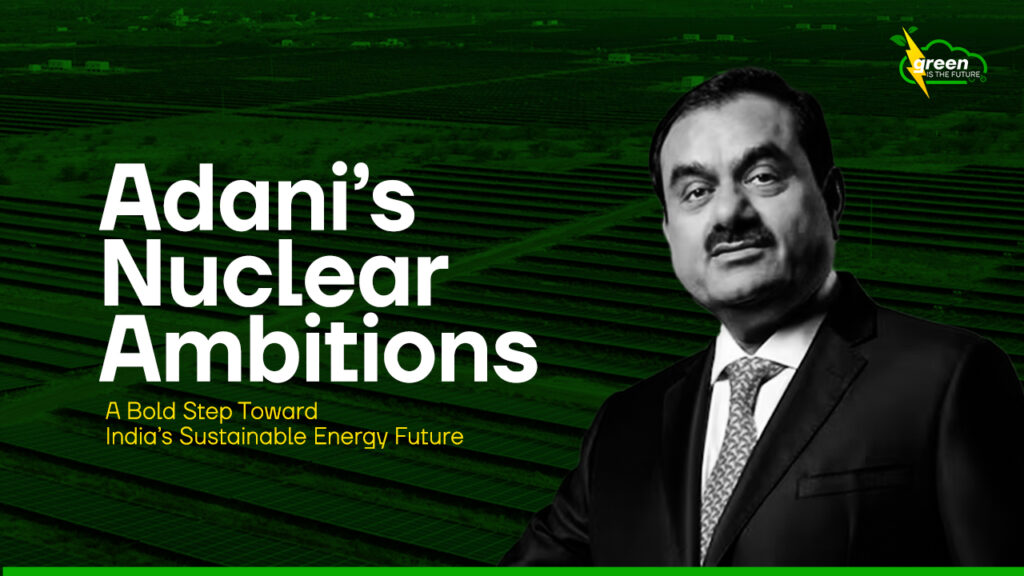Adani steps into nuclear energy, marking a bold move toward India’s sustainable energy future with plans to expand clean power solutions. As India races towards its ambitious clean energy goals, a new and surprising entrant is joining the nuclear mainstream: the Adani Group. Having made its mark as solar and wind industry giants, Adani is now turning to nuclear power, a game-changing shift in its energy mix—and perhaps India’s. With plans to develop a staggering 30 GW of nuclear power capacity, Adani’s move could redefine how we think about sustainable energy in a country aiming for 100 GW of nuclear power by 2047. But what does this mean for India’s green future? Let’s dive in.
A Nuclear Pivot for Adani
On Feb 18, 2025, Gautam Adani, Group Chairman of Adani Group, made headlines after he paid a visit to the Tarapur Maharashtra Site (TMS), India’s first nuclear power plant. He was accompanied by top officials of Adani Energy, Adani Green, and the conglomerate’s energy strategy department, as Adani went on a tour of the operational and technological complexities of nuclear power. This wasn’t just a courtesy call—sources indicate it’s part of a broader plan by Adani Power to replace its entire 17.55 GW thermal capacity with nuclear energy in the coming years, with an eye on scaling up to 30.67 GW by 2030.
The timing couldn’t be more significant. Just weeks earlier, Union Finance Minister Nirmala Sitharaman announced in the 2025-26 Budget a Rs 20,000 crore Nuclear Energy Mission, aimed at advancing research and deploying five small modular reactors (SMRs) by 2033. The government also proposed opening the nuclear sector to private players—a policy shift that Adani seems poised to capitalize on.
Why Nuclear? Why Now?
For a solar and wind energy giant such as Adani, the move to nuclear would be surprising. But it would be reasonable for India’s dual mandate: reducing carbon emissions without falling behind surging energy needs. Nuclear is a low-carbon, reliable option compared to coal-fired thermal power, which remains the majority of India’s grid. Unlike solar and wind, which depend on weather conditions, nuclear provides consistent baseload power—crucial for a nation industrializing at breakneck speed.
Adani Power’s current thermal fleet, while efficient, is a relic of a fossil-fuel past that India is eager to move beyond. Replacing it with 30 GW of nuclear capacity can eliminate millions of tons of CO2 emissions every year, in line with India’s net-zero-by-2070 commitment. Small modular reactors, which have been a star of the government plan, can be the clincher as well. Small, scalable reactors are quicker to deploy and less expensive than the huge nuclear power plants, and are a game-changer for Adani and other private sector entrants.
The Tarapur Takeaway
Adani’s visit to Tarapur wasn’t just symbolic—it was strategic. The delegation received detailed briefings from the Nuclear Power Corporation of India Limited (NPCIL) on the country’s nuclear program, including plant operations and future roadmaps. A field tour of the TAPS 3&4 units offered a firsthand look at the technology Adani might soon adopt or adapt. With international collaborations on technology and equipment on the cards, Adani would be able to use its international footprint to introduce India with state-of-the-art nuclear technology.
This move also comes at a pivotal moment for Adani’s energy division. Adani Energy Solutions already runs India’s largest private electricity transmission network, spanning over 20,500 circuit kilometers.
Challenges Ahead
Adani wants to overcome these issues while retaining public support—no easy task in a nation where nuclear projects have been opposed by locals for decades. The Palghar district, close to Tarapur, is already abuzz with industrial development, including the Vadhavan Port project. Combining nuclear power plants with the current mix can also be a cause of land use and environmental controversies.
Then there’s the question of execution. Adani’s renewable energy success—think sprawling solar parks in Gujarat—relies on rapid scaling and execution, but nuclear demands a different playbook: meticulous planning, regulatory approvals, and long gestation periods. Can Adani adapt its fast-paced approach to this complex domain?
A Green Future with Nuclear?
For readers of greenisthefuture.in, Adani’s nuclear push raises a big question: does nuclear fit the green energy mold? The answer isn’t black-and-white. Nuclear power boasts near-zero emissions during operation, making it a climate-friendly heavyweight. Yet, its lifecycle—from uranium mining to waste disposal—carries environmental trade-offs that renewables like solar and wind largely avoid.
Still, India’s energy reality demands pragmatism. With coal still fueling over 50% of the nation’s power, nuclear could be the bridge to a cleaner grid, complementing Adani’s renewable empire. If executed sustainably—perhaps with SMRs that minimize land and resource use—Adani’s nuclear venture could be a cornerstone of India’s green future.
What’s Next?
As of February 22, 2025, Adani’s nuclear plans are in the early stages, but the intent is clear. The company’s announcement of a 30 GW nuclear capacity target, reported by The Economic Times just yesterday, underscores its ambition. Whether Adani partners with global nuclear giants or leans on India’s homegrown expertise, this project could mark a turning point for private-sector involvement in the country’s atomic ambitions.
Everyone’s attention, for the moment, is on Adani as it navigates green philosophy and nuclear innovation. If successful, this could be more than a corporate milestone—it might just redefine sustainable energy for a nation of 1.4 billion. At greenisthefuture.in, we’ll be watching closely. Will Adani’s nuclear dream power India’s tomorrow? Only time will tell.

